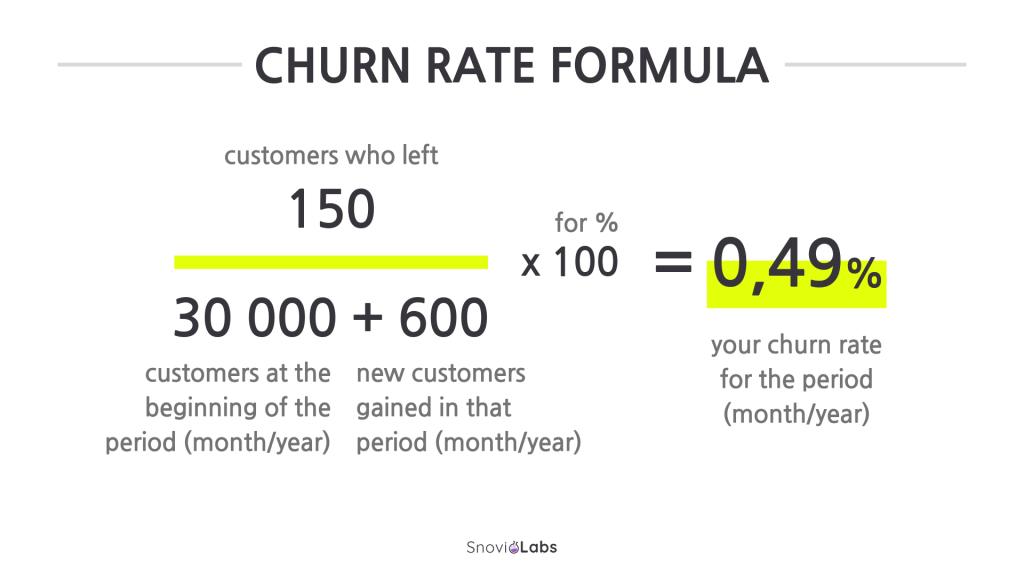Churn Rate – Business Definition – What does Churn Means ?
An important term startup companies use often is Churn rate. So what does Churn rate means exactly? And is it only important for startups?
What is customer churn?
Customer churn refers to losing customers or subscribers. Every company or service experiences churn whether it is in the short or long run. The less churn you have, the more your customers are loyal. Churn rate is closely related to average customer life time. But to measure churn you should have a subscription model (or at least a traceable repeating customer model).
What is churn rate ?
First, let’s define churn rate. Simply put, churn rate, is the percentage of lost clients. Two key words, percentage and lost. Churn rate can be measured in different ways, based on the time interval you select, it can be measured weekly, monthly, quarterly, yearly.
For example: A streaming service with 1000 subscriber, lost 100 subscribers this month.
The churn is 100 subscribers this month, but the rate is a bit more complex:
100/1000 * 100 = 10%
How do you calculate customer churn rate?
The formula requires to: divide the loss (100) by the total (1000), then multiply by 100 to get the percentage.
A simplified version would be: Churn = (Lost Customers ÷ Total Customers at the Start of Time Period) x 100.
For a monthly Churn rate it would be: (Lost Customers in the last 30 days ÷ Active Customers 30 days ago) x 100
Then you can average the values to get an average churn rate for a specific period, or you can calculate a churn rate on a longer period.
So as you already have understood, churn is to understand how much the company is losing customers (monthly/yearly etc …), irrelevant of the customer growth.
Shouldn’t churn rate take in consideration new customer?
There is another formula that takes in consideration the new customers in calculating the churn rate, this formula is:
(Lost Customers ÷( Total Customers at the Start of Time Period + New Customers)) x 100
However this formula makes no sense and gives no real metric, as it is mixing growth with churn and ending up polluting the data.
It might be used by sneaky founders, to falsely reduce the real churn rate (for pitching purposes).
Churn rate is to know how much you lose customers, irrelevant of the marketing effort.
If we need to take growth in consideration, we do not need churn rate, growth rate would suffice, as growth rate being (new-lost)/total *100.

Why is Churn rate important mostly to startups?
The churn rate is not only important for startups, but it is mostly used by tech startups due to the business model many startups adopt (subscription or SAS) and the ability to easily track their customer-base.
By measuring the rate of customers you are losing, you can have a strong metric to measure the effectiveness of the improvements your service or product have. It can also be a way to reach the optimal price point (cost of the service or product).
A negative churn rate
Based on the churn rate formula, you would think it is not possible to have a negative value. Well, you would be wrong, it is possible if you switch to another metric or criteria, for example revenue. Churn rate by definition is a way to measure loss, but some sophisticated economists came up with the idea of negative churn rate when it comes to revenue, and that when the revenue increases due to addons and upgrades, even if customers are lost.
For example: 100 stopped playing your mobile game thus you lost 100$ in ads revenues but 200$ were generated by new upgrades purchased by existing customers.
What is a good churn rate?
This is a tricky question, if you look it up online, you will see different values ranging from 2-5% to 15-20%. But i think this should be business specific and interval specific. Let’s look at this in a logical way:
– You first need to decide what is a good customer lifetime value for your customers, based on your Customer Acquisition Cost.
– Then determine the average customer life time to generate this CLV.
– Then calculate the yearly churn (or monthly churn) that satisfy the above conditions. For example if you only need the subscribers to subscribe for 1 year, then find the monthly churn (some mathematics might be required).
– Voila, a good churn rate would be any churn rate under the above calculated one.



